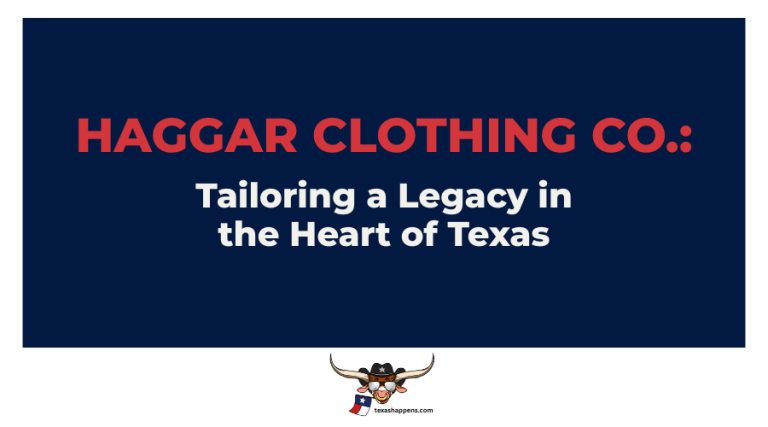Haggar Clothing Co. began in 1926 in Dallas with a single room and a vision for quality, affordable menswear. You’ll recognize their innovations like the Comfort Waist technology and pre-cuffed pants that revolutionized the industry.
Through three generations of family leadership before Randa Apparel & Accessories’ acquisition in 2019, they’ve grown from crafting 75,000 pants annually to a global brand with $500 million in revenue. Their legacy extends beyond fashion into American sports culture.
A Dallas Institution: The Founding Story of Haggar
In 1926, Joseph Marion Haggar, Sr.set up shop in Dallas, Texas, planting the seeds for what would become an American clothing empire. Starting with just a one-room office, Haggar’s vision quickly took shape as he focused on creating quality dress pants at affordable prices.
The company’s growth was remarkable. By 1928, just two years after its founding, Haggar had expanded to employ 500 workers who produced an impressive 75,000 pants annually. This rapid scaling showcased the founder’s business insight and the public’s hunger for well-made slacks.
This Dallas institution would eventually revolutionize the industry with innovations like pre-cuffed and wrinkle-resistant pants, setting the stage for Haggar to become America’s largest slacks producer by the late 1940s.
The Haggar headquarters found a fitting home in The Cedars neighborhood, contributing to the area’s transformation from Victorian homes to its modern blend of industrial heritage and creative revival.
Innovation in Menswear: Signature Products and Breakthroughs
View this post on Instagram
Haggar’s rapid rise from a small Dallas workshop to industry leader wasn’t just about business acumen—it was driven by genuine innovation that transformed how American men dressed. When you slip into a pair of Haggar pre-cuffed or wrinkle-free slacks, you’re experiencing breakthrough design that changed the industry.
The company’s groundbreaking Comfort Waist technology offers you a customized fit and mobility unlike anything before it. Their TrueFit sizing algorithm simplifies online shopping with precise size matching. Perhaps most iconic, Haggar Clothing Co. designed the legendary gold jacket worn by Pro Football Hall of Fame inductees, weaving the brand into American sports tradition.
Today, the company continues its forward-thinking spirit through sustainable fabrics and manufacturing, proving its commitment to both style and environmental stewardship. Similar to how Jack Kilby’s innovations at Texas Instruments transformed technology, Haggar’s contributions fundamentally changed menswear.
From Family Business to Global Brand: Leadership Through the Decades
Three generations of Haggar family leadership built the foundation for what would become a global menswear powerhouse. When Joseph Marion Haggar Sr. founded the company in 1926, he couldn’t have foreseen its evolution to include partnerships with institutions like the Football Hall of Fame.
After Ed Haggar’s brief presidency in 1971, the company began transitioning beyond family leadership. David Perdue joined as Senior VP in 1998 and later became CEO in 2001, ushering in a phase of professional management. Leaders such as Terry Lay, Jim Lewis, and Paul Buxbaum continued to modernize the brand.
Haggar’s evolution mirrored the trajectory of Conrad Hilton, who expanded from a single Texas hotel to a globally traded name.
Today, under Michael Stitt’s leadership (beginning in 2012), Haggar continues to thrive, following its 2019 acquisition by Randa.
Dressing America: Notable Retail Partnerships and Distribution
View this post on Instagram
From modest roots in a Dallas facility, Haggar has expanded its footprint to over 10,000 stores across North America. You’ll find their menswear in major retailers including Macy’s, Target, and Belk in the U.S., Canada, and Mexico.
Beyond brick-and-mortar retail, Haggar built prestigious collaborations, designing exclusive attire for the Pro Football Hall of Fame and various basketball halls. These partnerships helped the company reach $500 million in revenue prior to its acquisition.
In addition to their own brand, Haggar produces clothing for labels like Kenneth Cole, reinforcing their influence across the menswear category in North America.
The Gold Standard: Haggar’s Iconic Role in Sports Hall of Fame Ceremonies
Perhaps the most recognized thread in Haggar’s partnerships is their contribution to sports legends. Since 1978, Haggar has been the exclusive designer of the gold jackets awarded to Pro Football Hall of Fame inductees. When a legend puts on that shimmering blazer in Canton, Ohio, you’re witnessing Haggar’s craftsmanship.
Their ceremonial attire legacy spans beyond football, including work with the Naismith Memorial Basketball Hall of Fame and the International Boxing Hall of Fame. These associations elevate Haggar’s identity from clothier to symbol of excellence. Through these prestigious roles, Haggar weaves itself into the story of American athletic achievement.
Cultural Impact: Haggar in Advertising and Popular Media
Haggar’s marketing legacy stretches across decades of American culture. As one of the early pioneers in TV advertising, they earned exposure on the Today Show during the 1950s, propelling their slacks to a national stage.
Celebrity endorsements became a staple, with names like Mickey Mantle, Arnold Palmer, and John Travolta helping shape public perception of the brand. These campaigns culminated in their celebrated work with the Pro Football Hall of Fame.
Haggar even appeared in pop culture, notably in a 1998 episode of The Simpsons, where Krusty the Clown jokingly admits to stealing Haggar pants. These humorous and heartfelt nods underscore the brand’s integration into American consciousness.
Modern Evolution: Sustainability and Contemporary Fashion Initiatives
As environmental awareness increases, Haggar meets modern expectations by prioritizing sustainability. Their initiatives reflect a new era of menswear guided by responsibility and innovation.
Instead of traditional processes, they’ve adopted forward-looking practices:
- Recycled polyester transforms plastic waste into practical fabric
- Organic cotton ensures environmental health and fair agricultural labor
- Energy-efficient store designs reduce environmental impact
- Partnerships with water-saving textile facilities
- Garment recycling programs that minimize landfill contributions
Haggar’s eco-conscious direction is not just a marketing move—it represents a core evolution of a Texas legacy brand responding to the demands of the present and the promise of the future.


